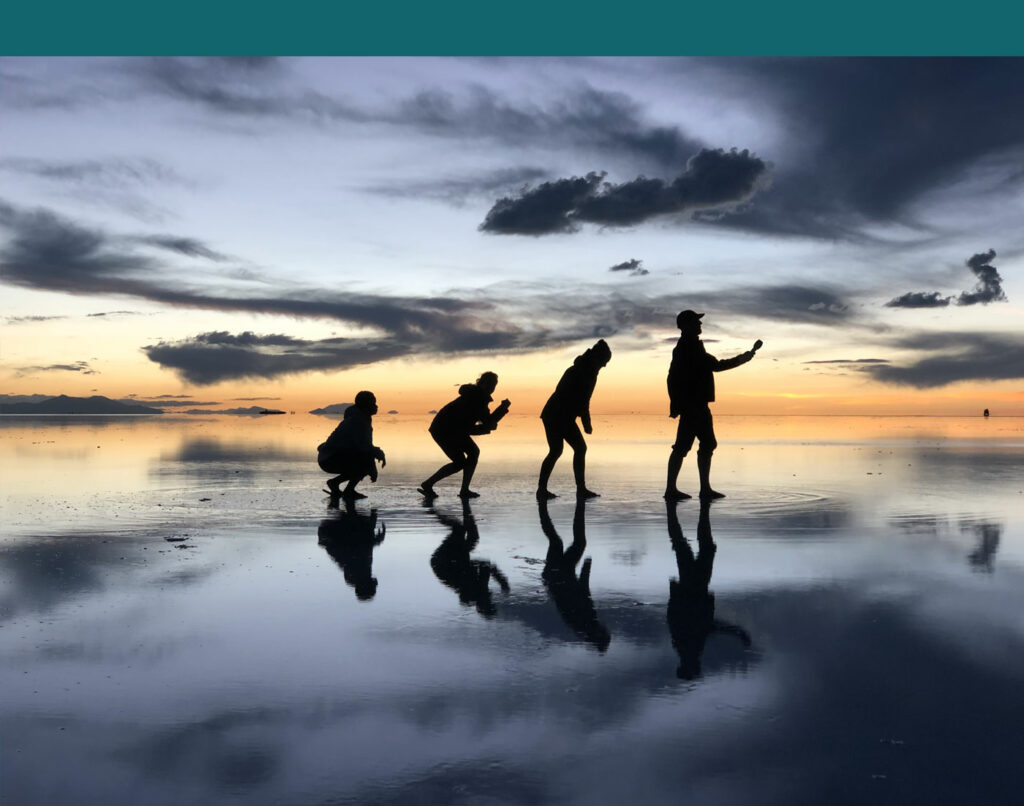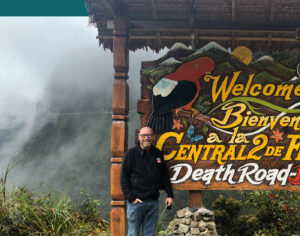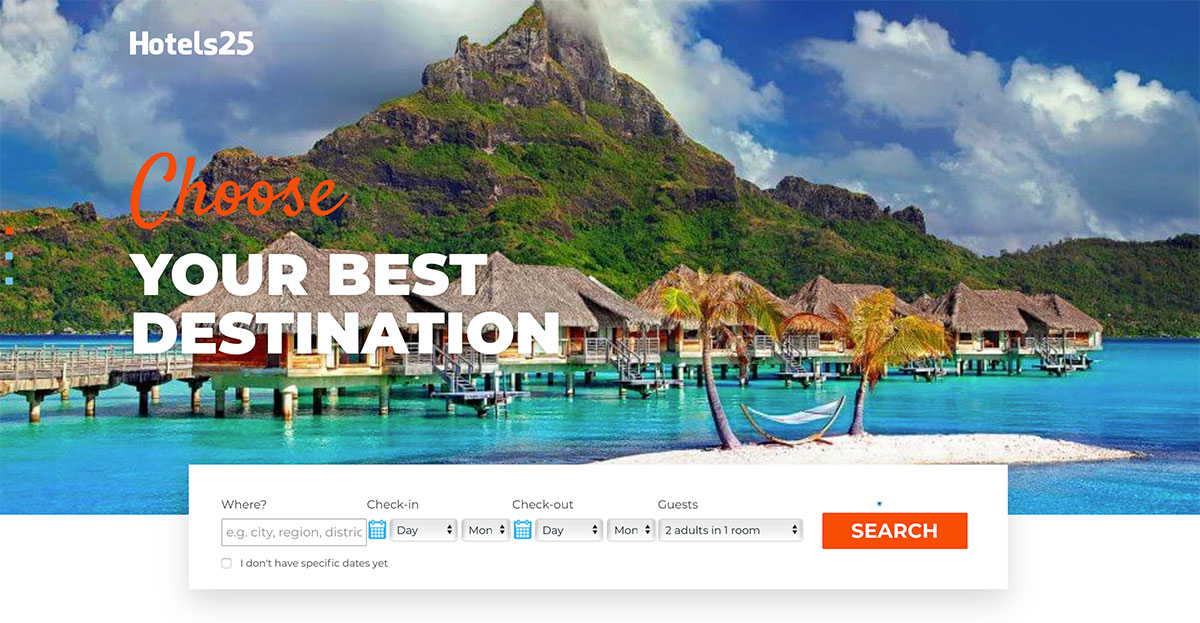Today we’re in Southern Bolivia for this leg of my South American journey, in one of the most remarkable landscapes on earth. We’re in Uyuni Salt Flats.
I took the night bus with my good friend, Alex from La Paz and arrived in Uyuni at 5 am in the morning. Thankfully there was a café open, so we were able to have breakfast and do some work until the tour started at 10.
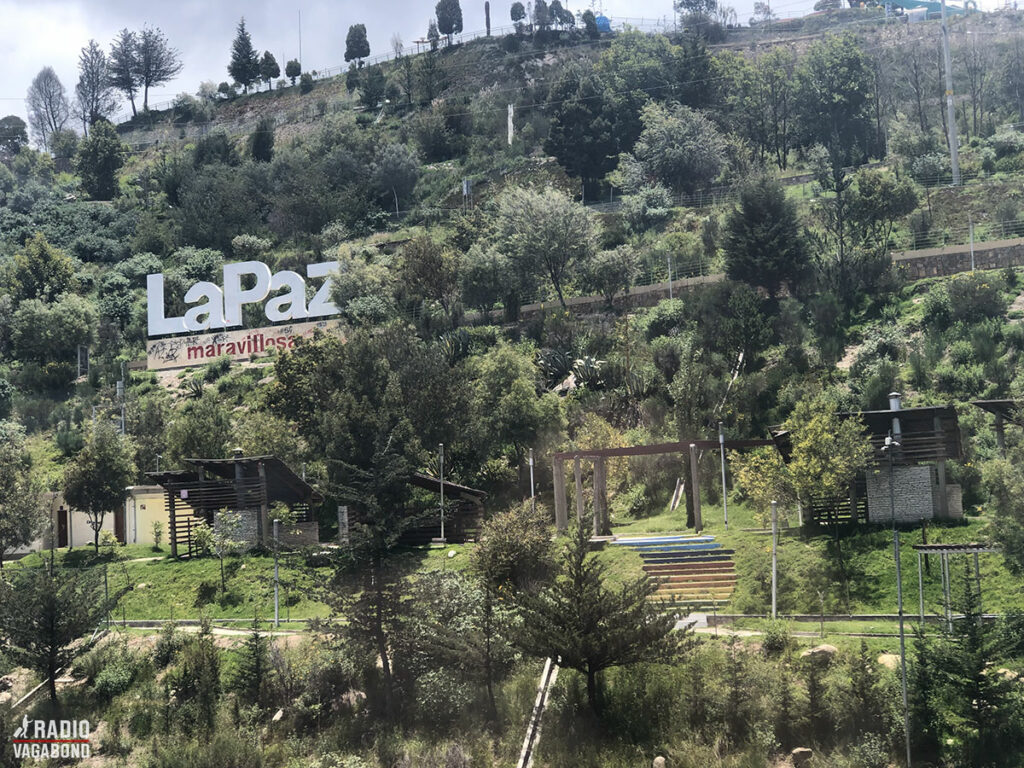
La Paz is not the Capital
If you’re listening to the episode (and you should), you might have noticed I said something wrong. I said that La Paz is the highest capital in the world. This is not 100% accurate. It is high – sitting at an altitude of approximately 3,650 meters (11,975 feet) above sea level, but it’s not the capital. The official capital of Bolivia is, in fact, Sucre.
But it’s a common mistake. I just watched a travel documentary on the BBC with Simon Reeves, and he said the same thing, so I don’t feel too bad about it.
La Paz is often referred to as the administrative capital and is home to most of the government offices and institutions.
La Paz is also Bolivia’s largest city, located at a higher altitude than Sucre and is famous for its unique geography, with buildings and neighbourhoods nestled in a deep valley surrounded by mountains. I covered my visit to La Paz and the legendary “Death Road” in an earlier episode.
Sucre, on the other hand, is located in the southeastern part of Bolivia and is known for its well-preserved colonial architecture, which has earned its recognition as a UNESCO World Heritage Site. Sucre played a crucial role in Bolivia’s fight for independence from Spanish colonial rule and was named after Antonio José de Sucre, one of the independence movement’s leaders.
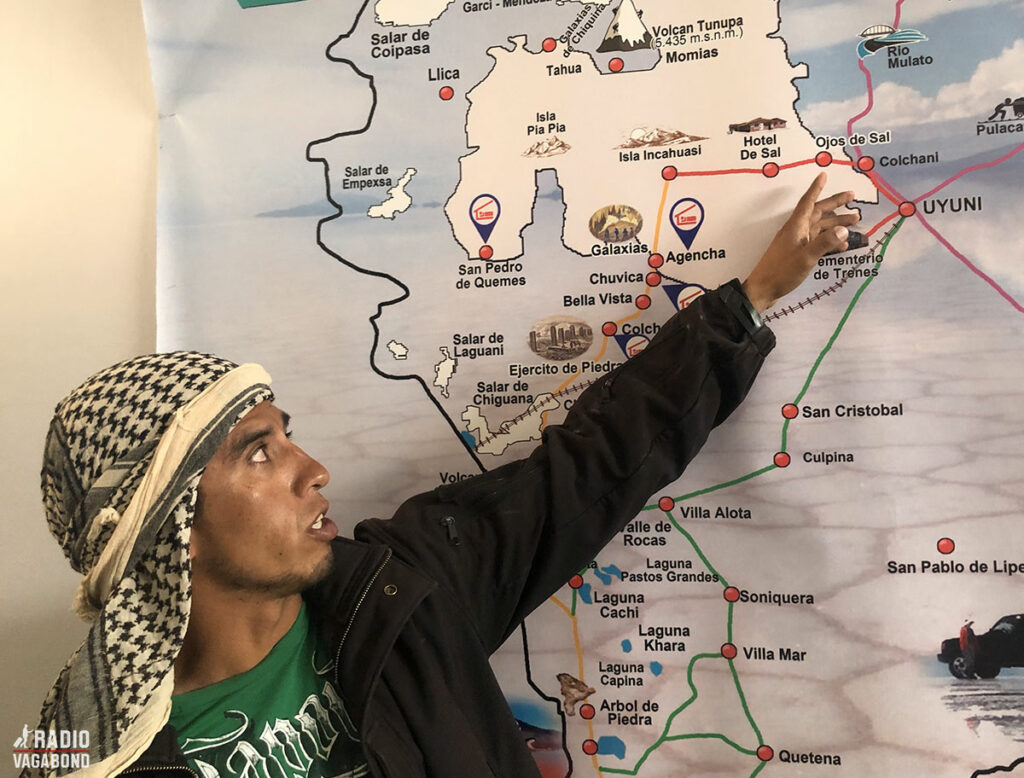
The Train Cemetery
After our guide, David, tells us where we are going on this three-day tour, we head towards the first stop, “The Train Cemetery,” to see the first locomotives in Bolivia. This train graveyard, locally known as “Cementerio de Trenes,” is a fascinating and eerie attraction located just outside the town of Uyuni in Bolivia. It is a place where old, rusting train locomotives and railcars from the late 19th and early 20th centuries have been left to deteriorate and slowly decay in the harsh, arid landscape of the Bolivian Altiplano.
It’s a surreal and somewhat post-apocalyptic sight. The landscape is dotted with lots of abandoned locomotives and train carriages, which are now covered in rust and graffiti. The trains vary in size and type, from massive steam locomotives to smaller railcars.
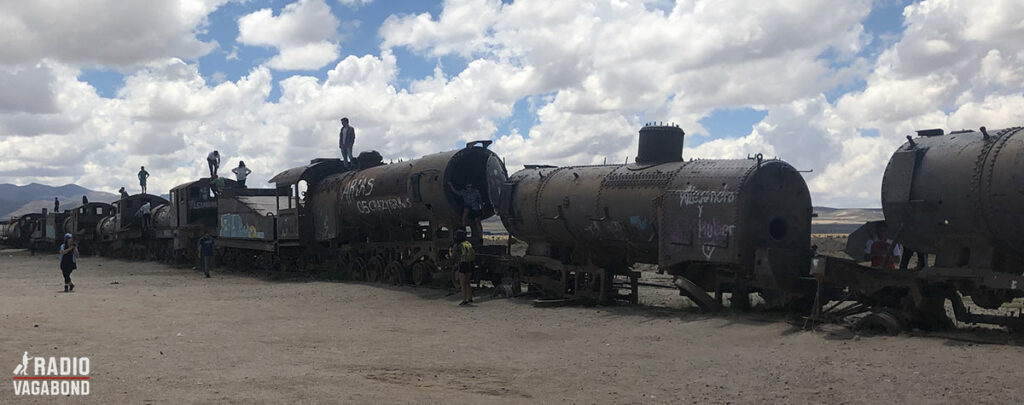
The rusted metal and the harsh, dry climate of the region give the place a desolate and otherworldly atmosphere.
The colourful graffiti on some of the trains adds a touch of urban art to the otherwise industrial and decrepit scenery. The trains are often covered in a layer of salt due to the nearby salt flats of Uyuni, and the salt can have a big impact on the trains here, in terms of accelerating rust and corrosion.
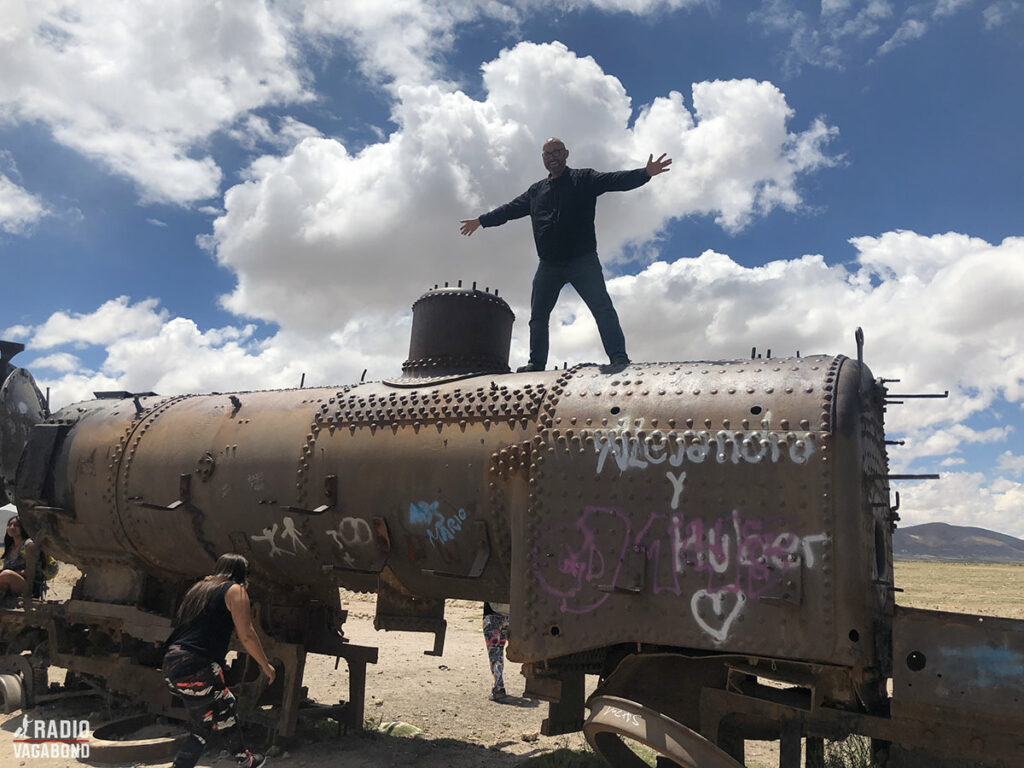
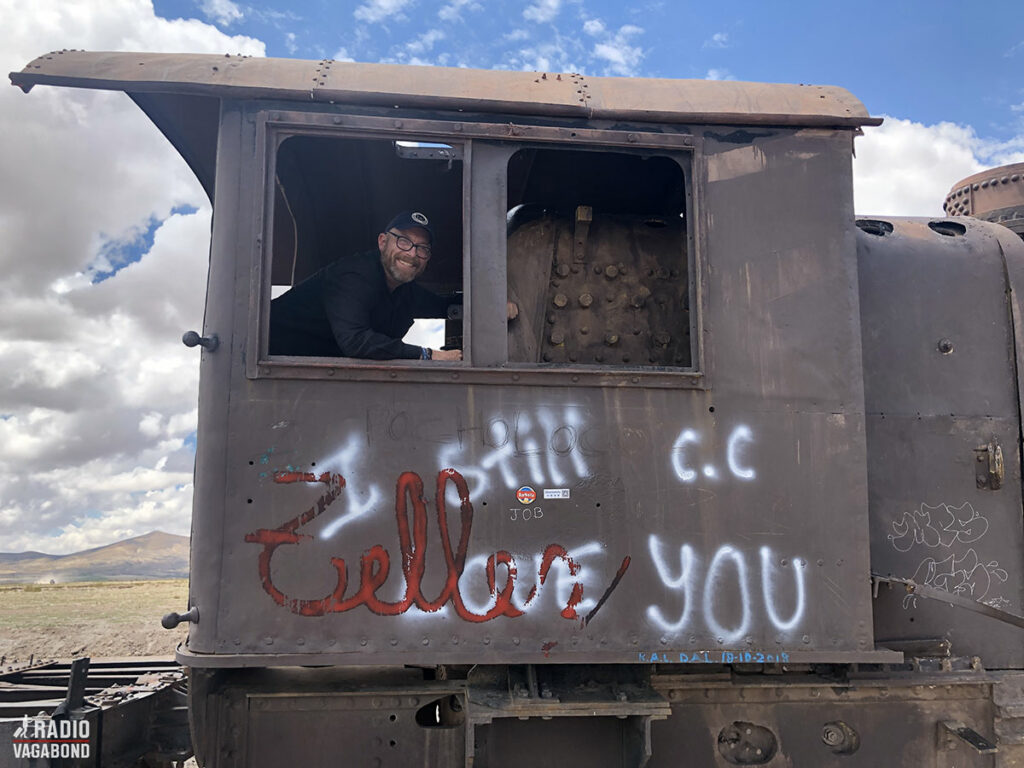
A LOOK IN THE HISTORY BOOK
The Train Cemetery has its origins in the late 18 hundred when Bolivia was attempting to develop a railway network to connect various parts of the country. Uyuni was an important railway junction, as a transportation hub for the mining industry in the region. But, with the collapse of this industry and the decline of the railroads in the mid-20th century, many locomotives and railcars were simply abandoned in this area.
Over time, the Train Cemetery has become a popular tourist attraction, drawing visitors from around the world. It has also become a hotspot for photographers and Instagrammers taking selfies. We like the unique and eerie ambiance, and the rusted trains and the surrounding landscape provide a surreal backdrop for creative photography.
In recent years, efforts have been made to preserve some of the trains and protect them from further deterioration, as they represent a unique part of Bolivia’s industrial and transportation history. x
The Train Cemetery is a captivating and haunting place that offers a glimpse into Bolivia’s past. A perfect add-on to your visit to the salt flats, and this is where we’re going now.
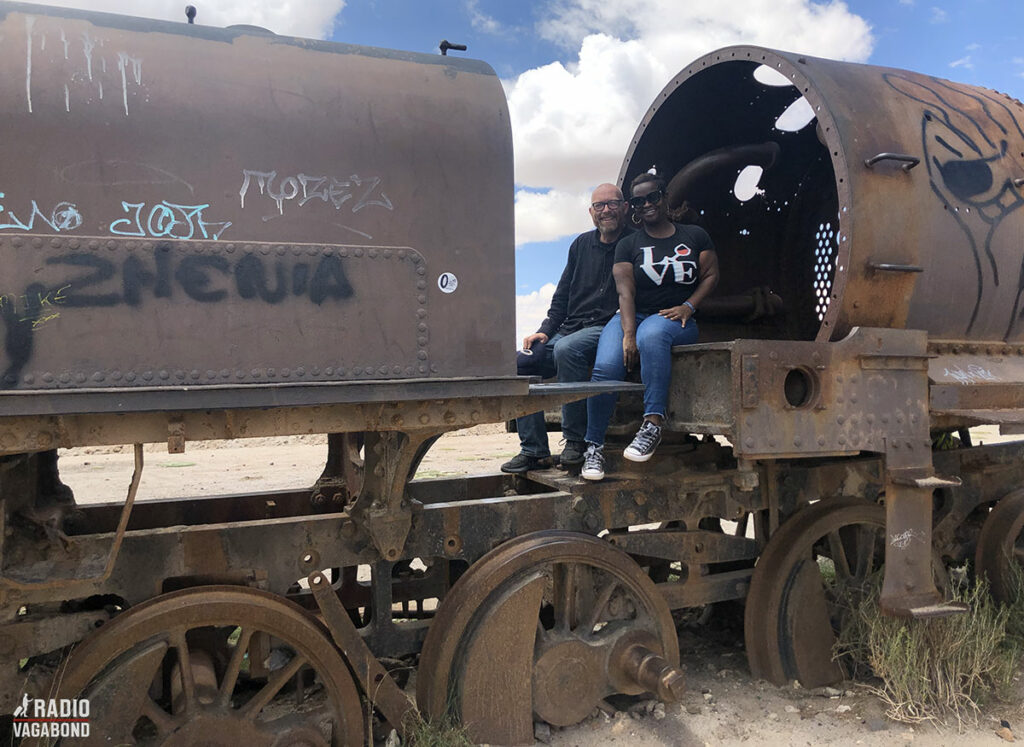
FACTS ABOUT BOLIVIA
Size and Population
Bolivia is one of the largest countries in South America, covering an area of approximately 1.1 million square kilometres (about 424,000 square miles) and has a population of around 11.5 million people. It’s known for its diverse mix of ethnic groups, including indigenous peoples, mestizos, and people of European descent.
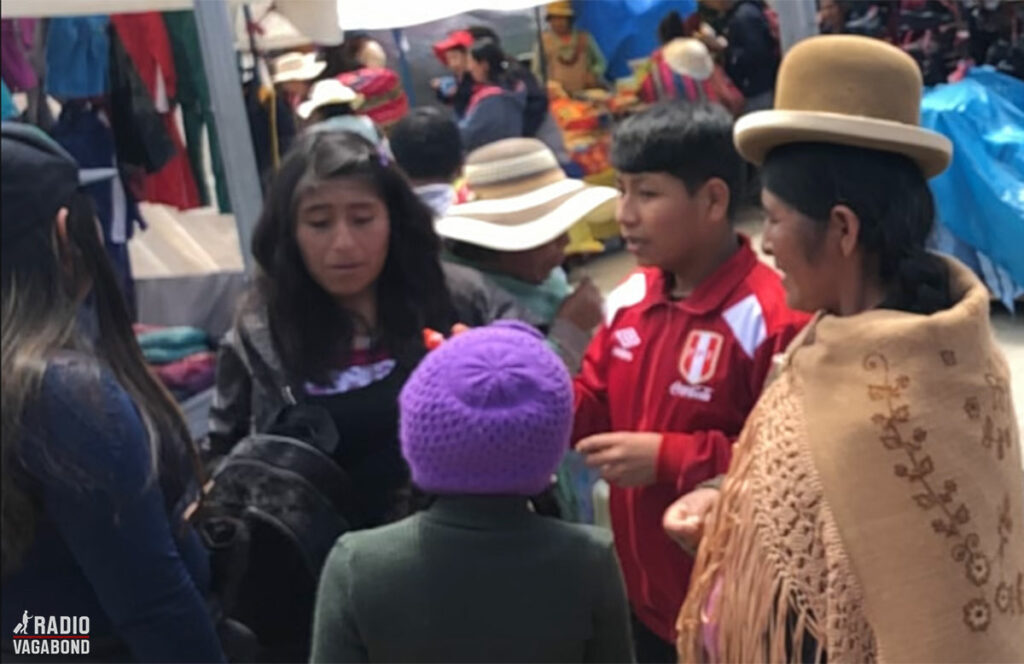
Religion
Bolivia is predominantly a Roman Catholic country, with a significant Catholic population. But it also has a blend of indigenous Andean beliefs, and many people practice a mix of Catholicism and elements of traditional indigenous spirituality.
Official Languages
The official languages of Bolivia are Spanish and indigenous languages. Spanish is by far the dominant language and is spoken by the majority of the population.
Lake Titicaca
Bolivia shares Lake Titicaca, one of the world’s highest lakes, with Peru. It is not only incredibly deep but also considered a sacred place in Inca mythology.
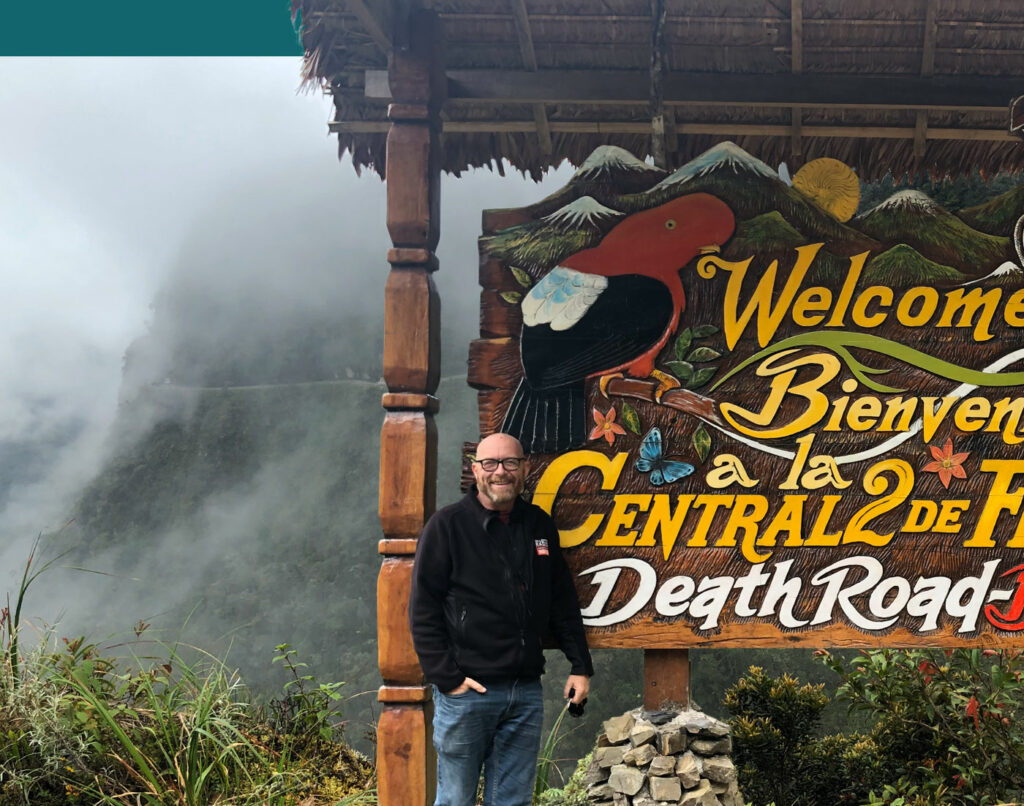
Yungas Death Road
Known as the “Death Road,” the Yungas Road in Bolivia was once considered the world’s most dangerous road. It’s infamous for its steep cliffs and narrow pathways, and it has claimed many lives over the years. I covered my visit to Death Road in another episode from Bolivia.
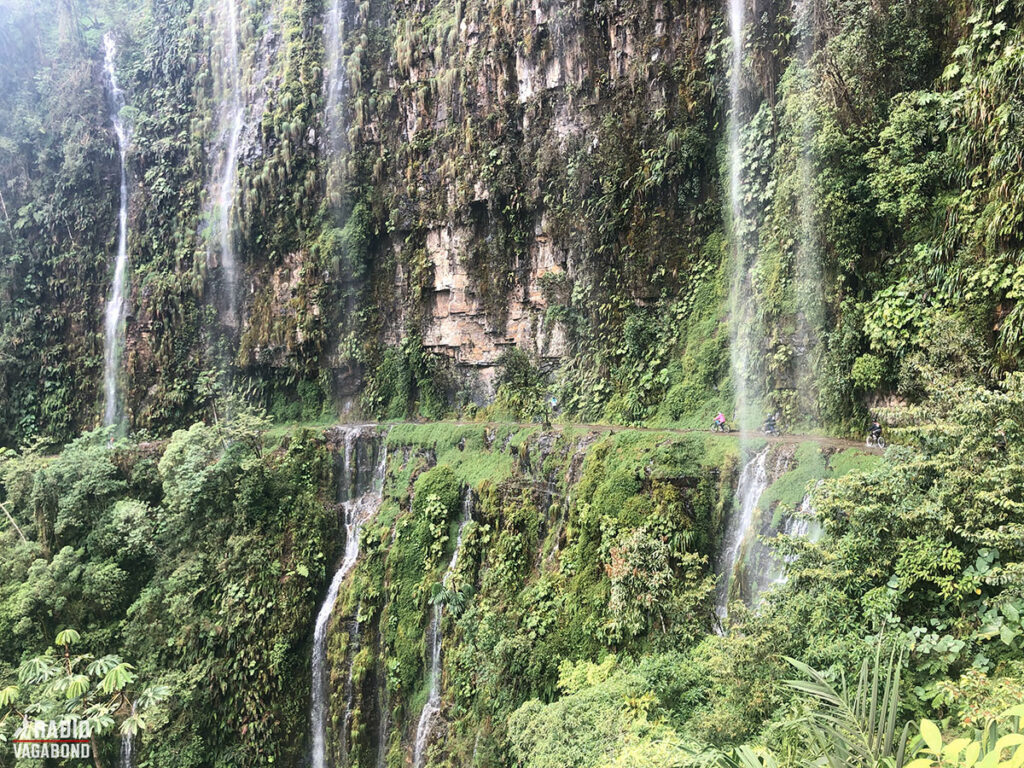
Potosí Silver Mines
During the Spanish colonial era, Potosí was home to the world’s largest and most productive silver mines. The wealth extracted from these mines was instrumental in funding the Spanish Empire.
Diverse Ecosystems
Bolivia boasts a wide range of ecosystems, from the Amazon Rainforest to the high-altitude Andes Mountains. This diversity supports a variety of wildlife, including jaguars, spectacled bears, and over 1,400 bird species.
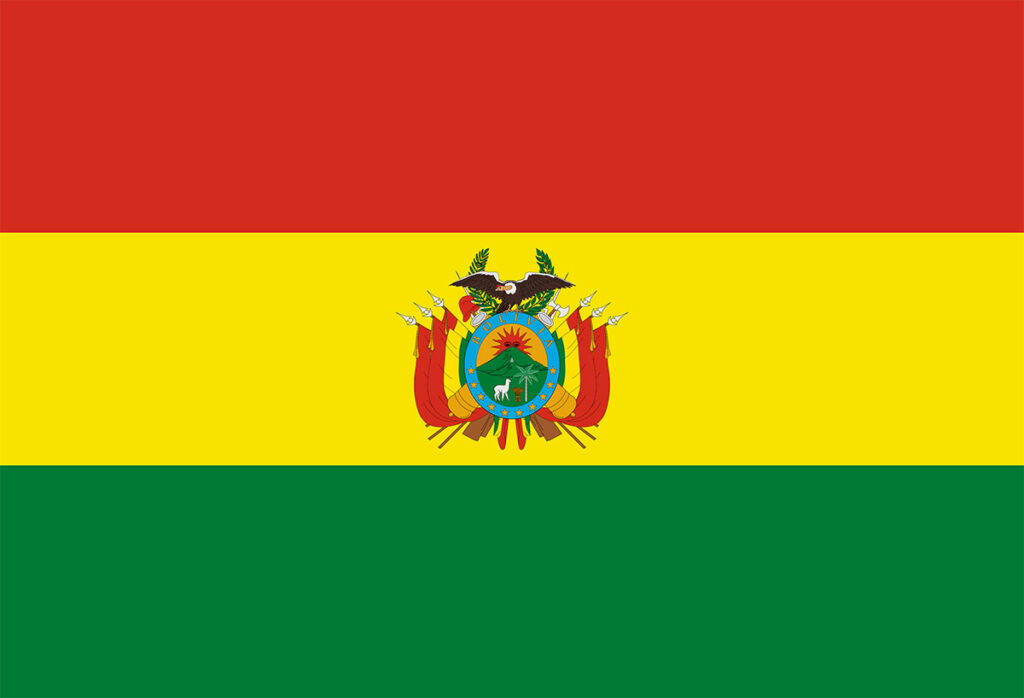
The Flag
Looking at their flag you will see three horizontal stripes: red at the top, yellow in the middle, and green at the bottom. In the center of the yellow stripe, there’s the Bolivian national coat of arms. The red represents Bolivia’s brave soldiers, the yellow symbolizes Bolivia’s mineral resources and wealth, and the green represents the country’s rich vegetation and fertility. So basically blood, gold, and plants. The coat of arms features a condor, a mountain, and the sun rising over a body of water. Bolivia’s scenic beauty and natural resources.
Local Food
Bolivian cuisine is diverse and includes unique dishes like salteñas (a type of savoury pastry), anticuchos (grilled skewers often made from beef heart), and llama meat prepared in various ways.
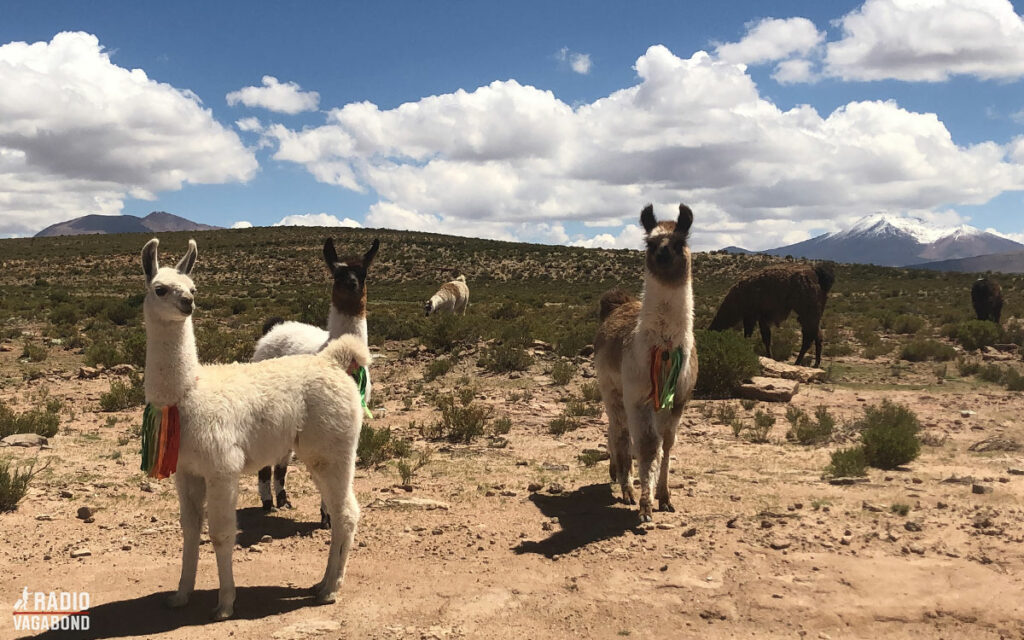
Local Beers
Bolivia has a growing craft beer scene, and there are several local breweries producing a variety of unique and flavourful beers. Popular local beers include Huari, Paceña, and Saya Beer. These beers often incorporate traditional Bolivian ingredients and flavours.
Famous Proverbs
Bolivia has a rich tradition of proverbs that offer wisdom and insights into life. Here are a couple of Bolivian proverbs. Here are two of them:
“El que mucho abarca, poco aprieta.”
“He who tries to grab too much holds too little.”
This proverb emphasizes the importance of focus and not spreading oneself too thin.
“El que es buen gallo, donde quiera canta.”
“A good rooster crows wherever it is.”
This proverb encourages people to showcase their talents and abilities wherever they go.
WHO ARE YOU?
Please spend five minutes taking a the survey – tell me a bit about who you are and what you would like more or less on here on The Radio Vagabond.
Can be Seen from the Moon
We’re heading to one of Mother Earth’s most surreal and breath-taking wonders: the Salar de Uyuni, also known as the Uyuni Salt Flats, here in the southwest corner of Bolivia, near the crest of the Andes.
10,000 square kilometres (4000 square miles) of salt flats. It’s the largest salt flats in the world and it’s said that you can see them from the moon – but why would you? It’s much more interesting to see up close. But its vastness is just the beginning. It’s truly one of the most remarkable landscapes on planet earth.
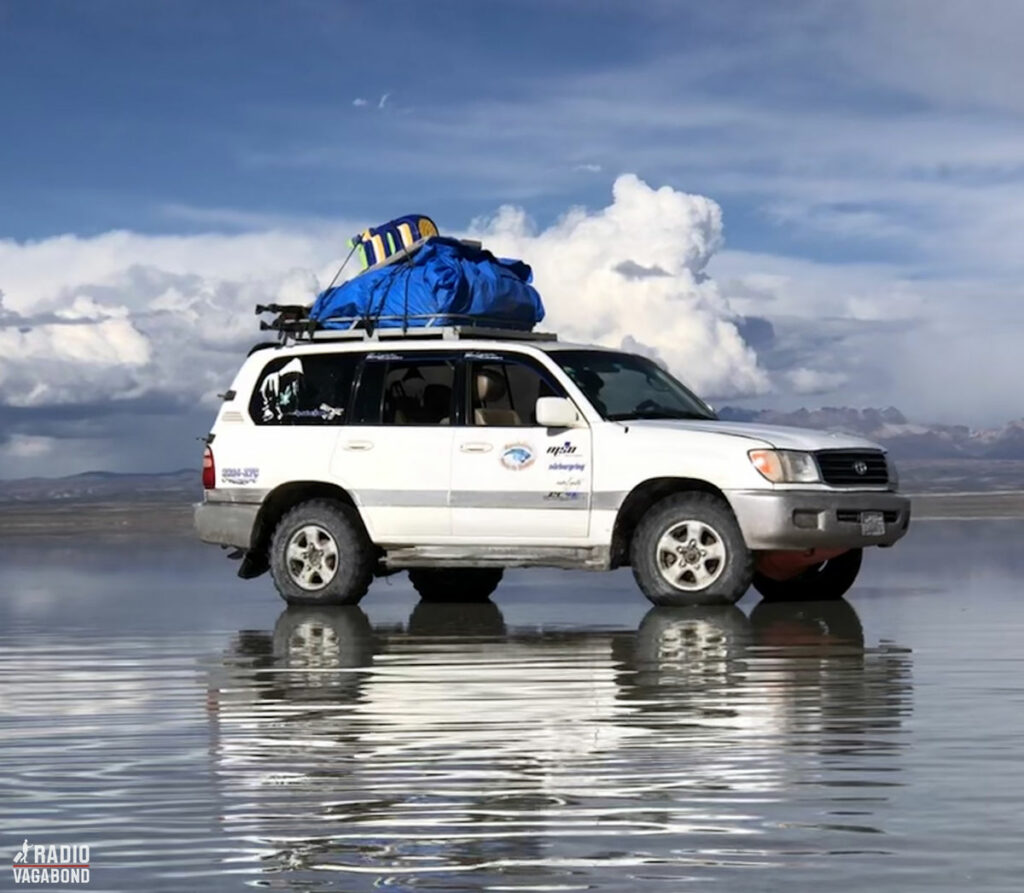
Here in the tropics the rainy season is roughly from November to April, and there’s a few inches of water on the flats. When it’s dry, the salt flats are completely white with pure, blinding-white salt.
I’m here in the rainy season which means that a thin layer of water is covering the salt crust. It creates a seamless reflection of the sky above and the boundary between the heavens and the Earth becomes blurred, as clouds, sunsets, and even bodies are duplicated on the salt flats’ mirror-like surface.

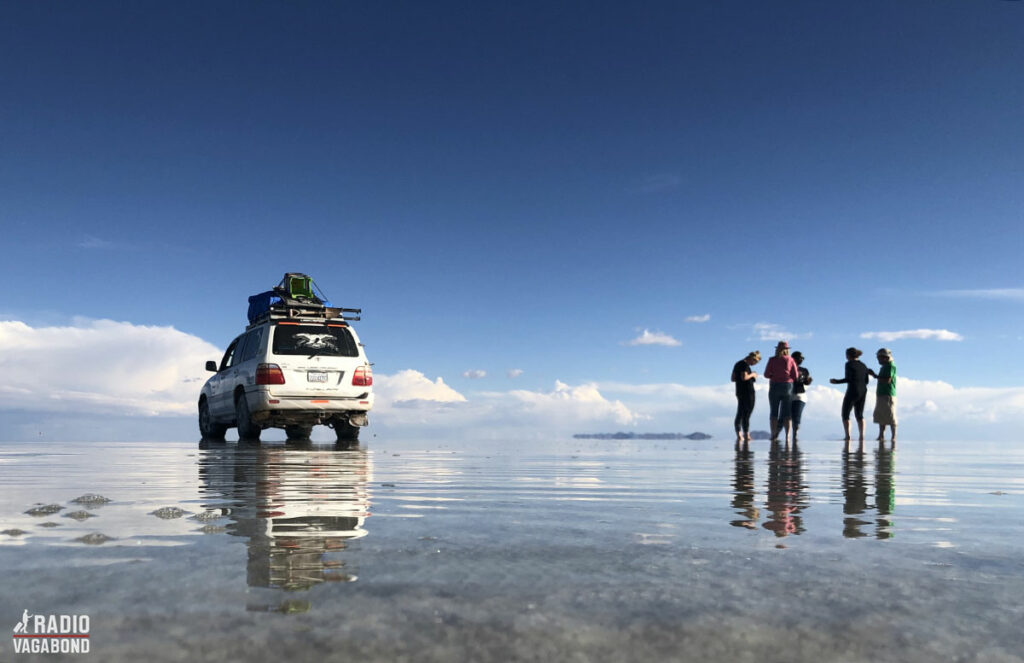
The Origin of the Salt
The Salar de Uyuni wasn’t always a pristine expanse of salt; its origins are as fascinating as its appearance. Millions of years ago, it was a massive prehistoric lake known as Lake Minchin. Over eons, it gradually transformed into the salt flats we see today. The salt crust is composed mainly of sodium chloride (table salt), making it a valuable resource for the region’s economy. In places the salt crust beneath us is up to ten meters deep. It’s said to be 10 billion tons of natrium chloride here. That’s a lot of salt for your fries.
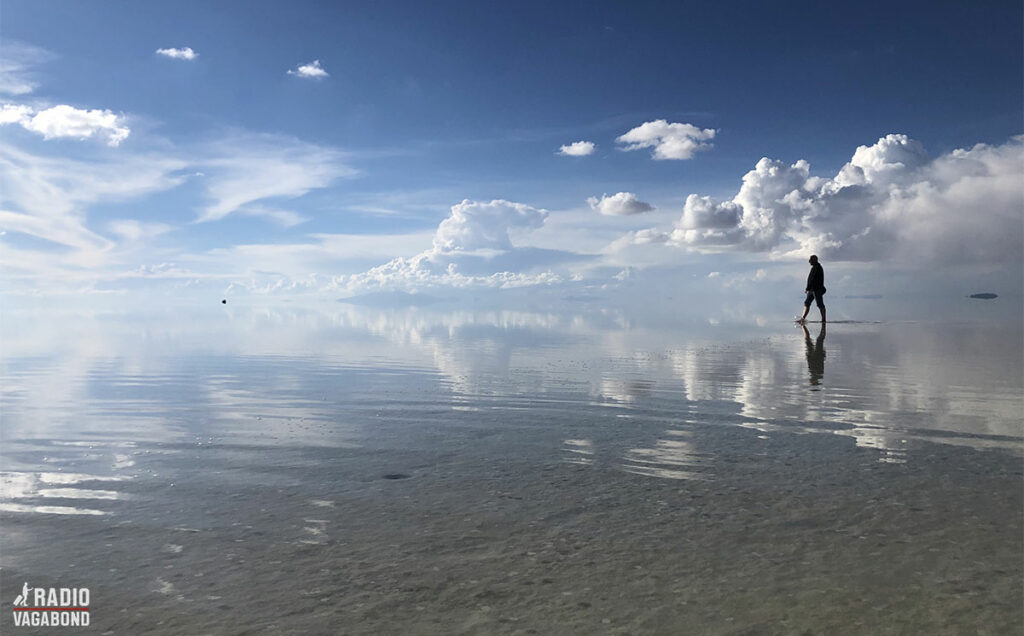
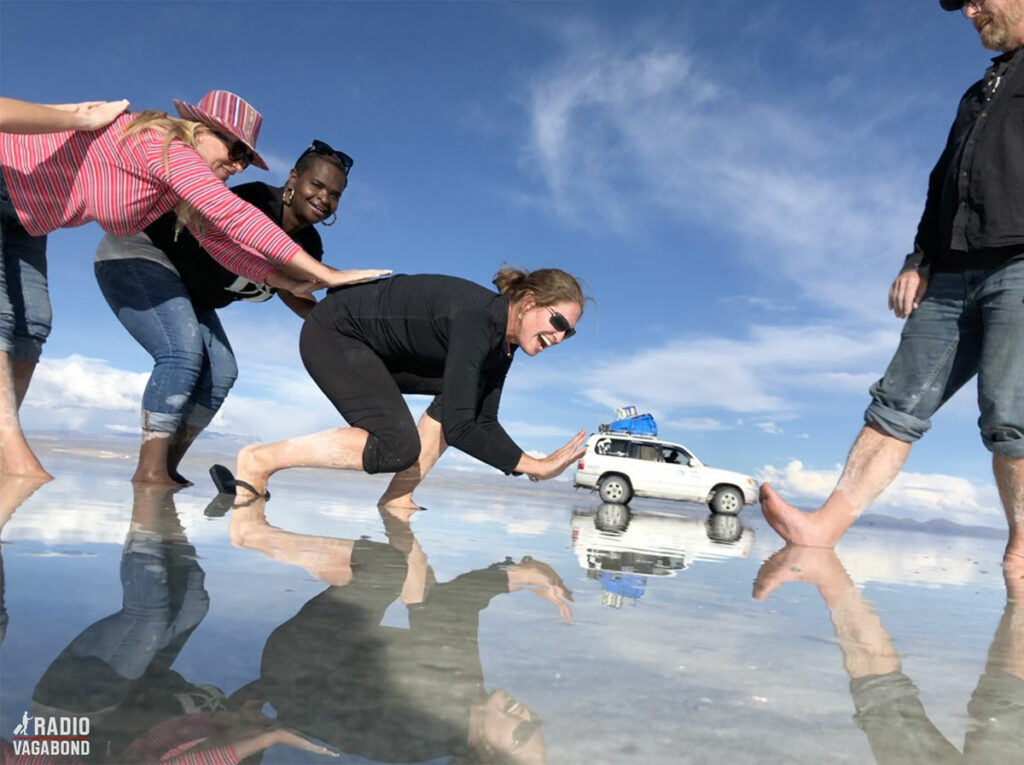
Exploring the Salar de Uyuni
Exploring the Salt Flats is an adventure like no other. It’s a photographer’s dream come true, where every angle reveals a new perspective. Like many other travellers, we – or rather our guides brought props like bottles and miniature figurines of small plastic dinosaurs to create whimsical optical illusions, making it seem as though they’re giants in a land of small people.
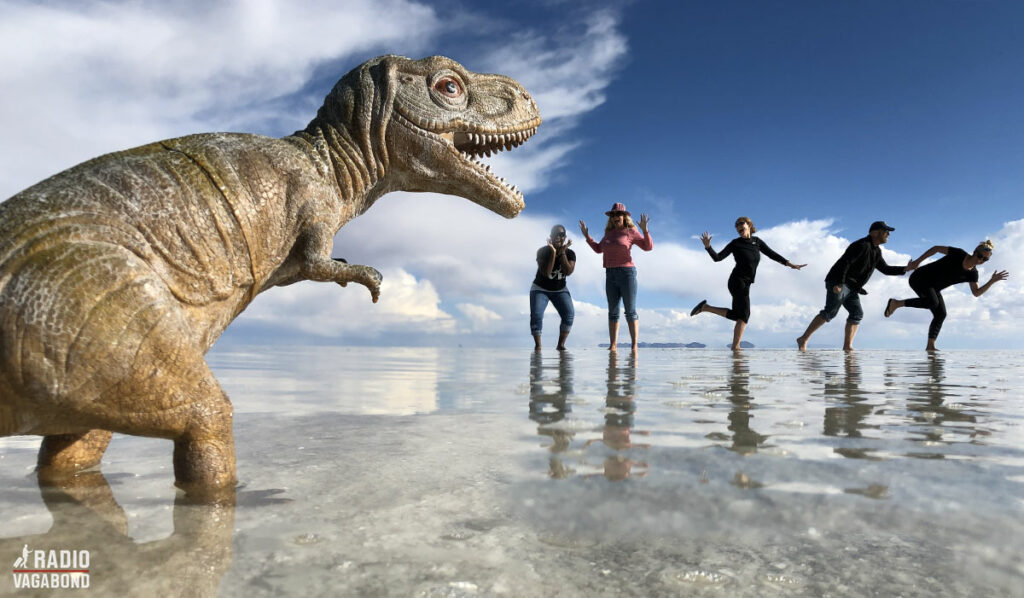
I found it a bit silly, but this is a surreal playground that encourages creativity and invites you to play with perspective, resulting in captivating and sometimes mind-bending photographs.
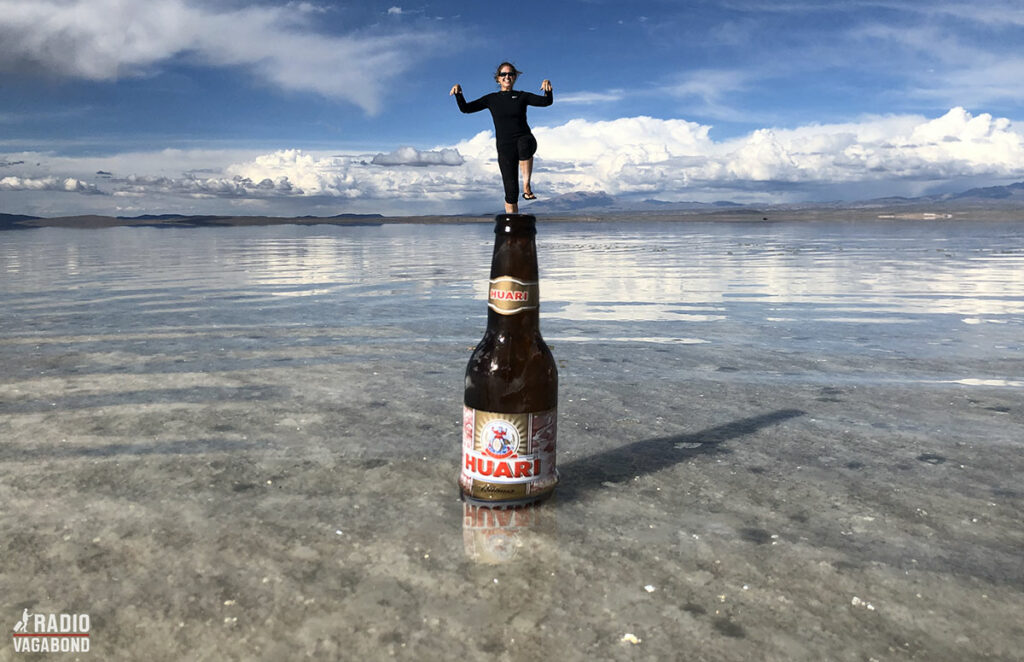
Lunch in the Mirror
David and our driver set up a small table and some plastic chairs in the middle of all this. And with our feet in the salty water, we had a wonderful and surreal lunch.
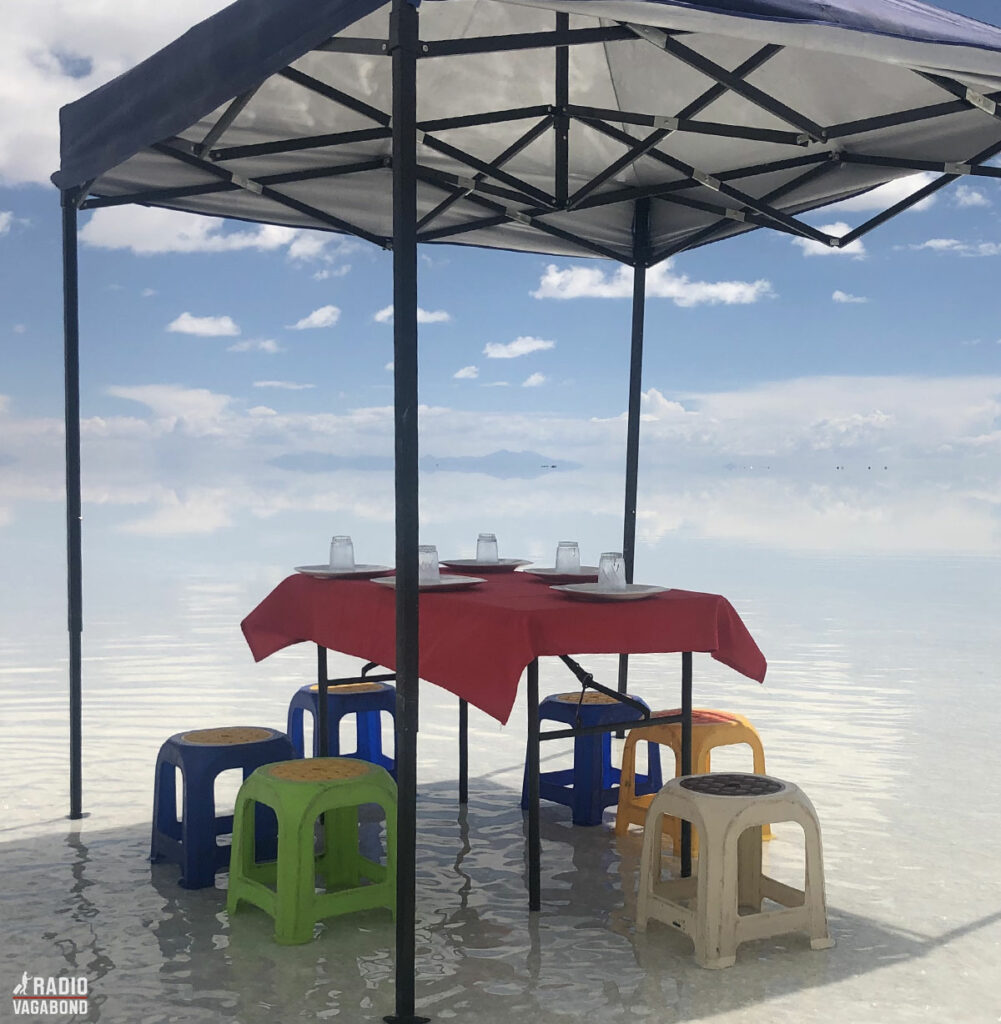
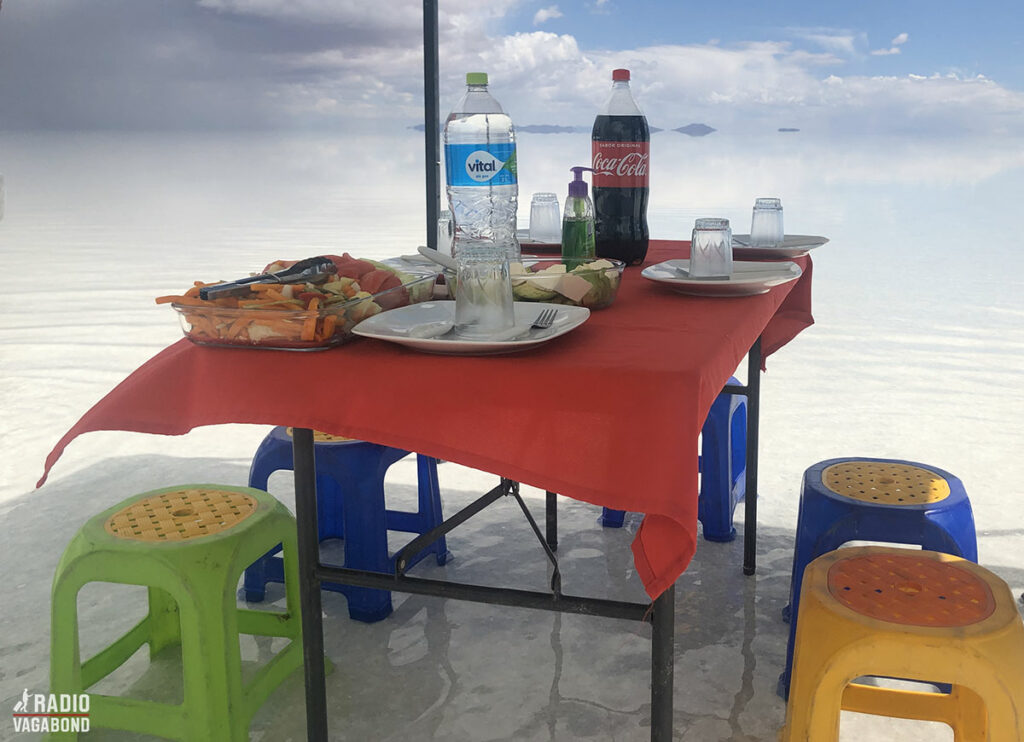
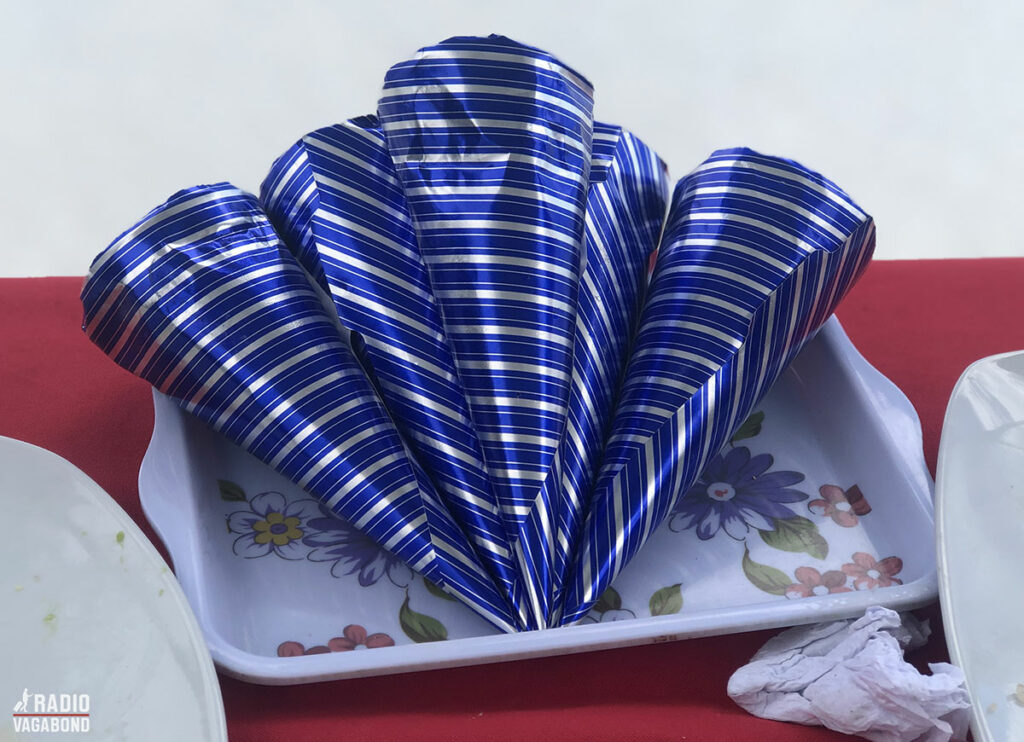
After lunch, I walk around by myself for 15-20 minutes. The vastness of the landscape and the eerie silence create a sense of peaceful isolation. There’s a meditative quality to this place, a reminder of how insignificant our everyday worries can seem in the grand scheme of the universe.
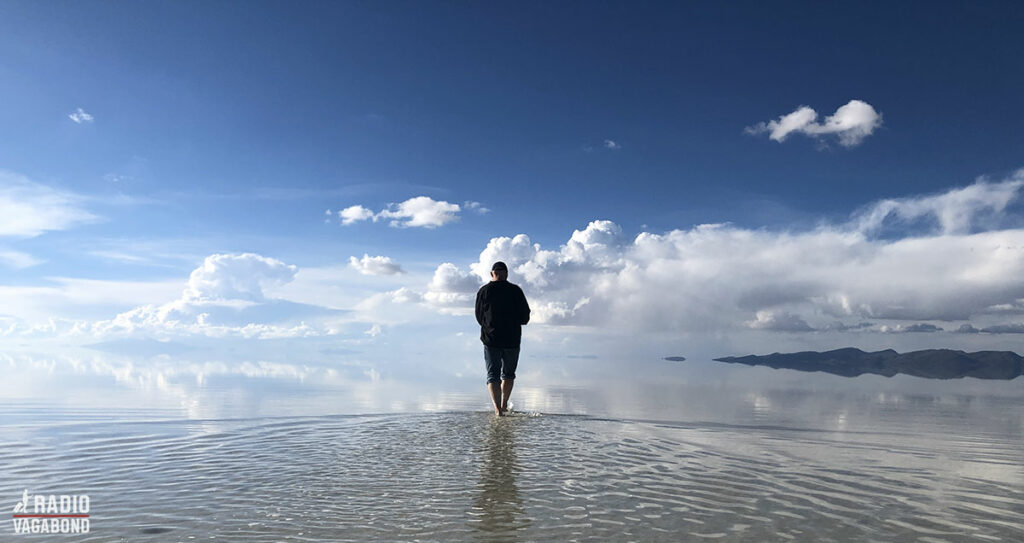
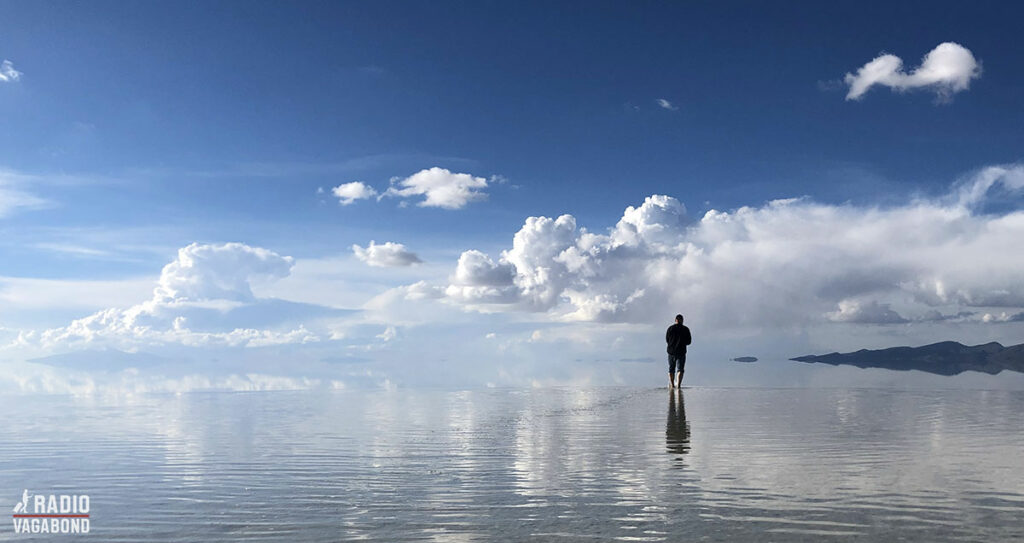
Salt Hotels
In addition to the stunning landscapes, the Salar de Uyuni also features salt hotels. The walls, floors, and even some of the furniture in these hotels are made entirely of salt blocks. They are surrounded by salt – so it’s a readily available and inexpensive building material here, making it an ideal choice for constructing these eco-friendly hotels.
And when these hotels are no longer in use or need repairs, the salt can be returned to the salt flat, leaving little trace behind.
The hotels often feature intricate and creative salt-based designs, including salt sculptures and carvings that add to the overall aesthetic appeal. Some rooms may have salt beds, tables, and chairs, offering guests a truly immersive experience.
So, if you’re having lunch there, you can just lick the walls if you want some salt with your food.
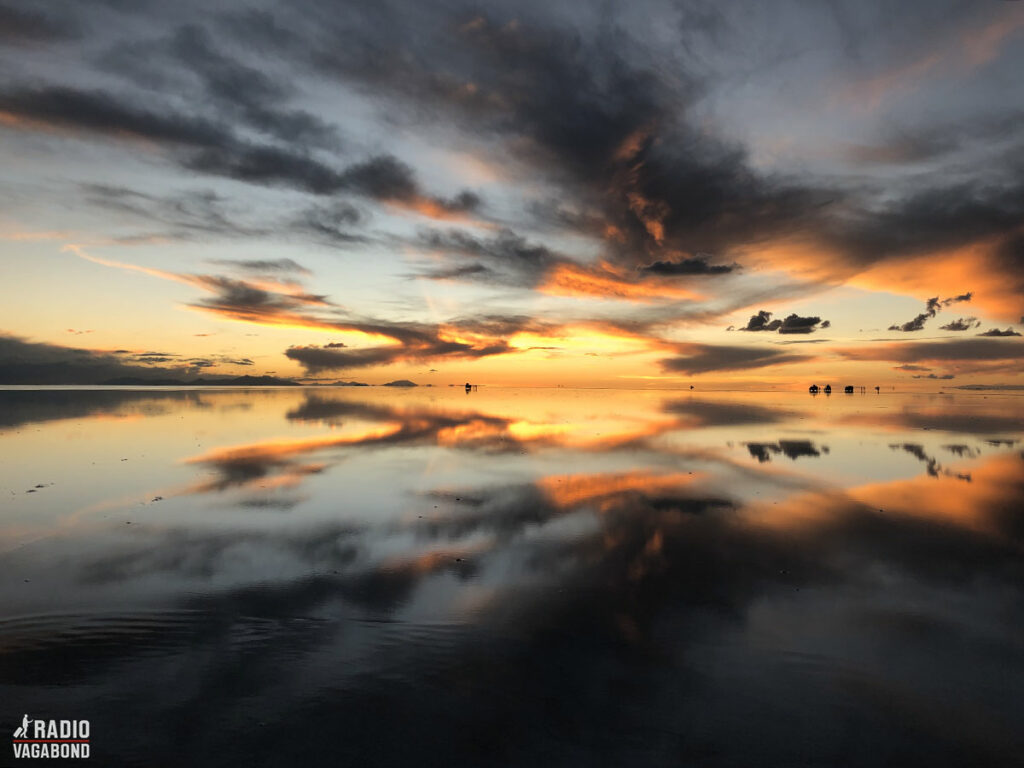
The Sunset and the Starlit Sky
As night falls, the Salar de Uyuni takes on a new personality. The colours of the sunset were nothing less that spectacular. And by far the most amazing sunset I’ve ever witnessed in my life. Again, we went nuts with taking pictures and videos.
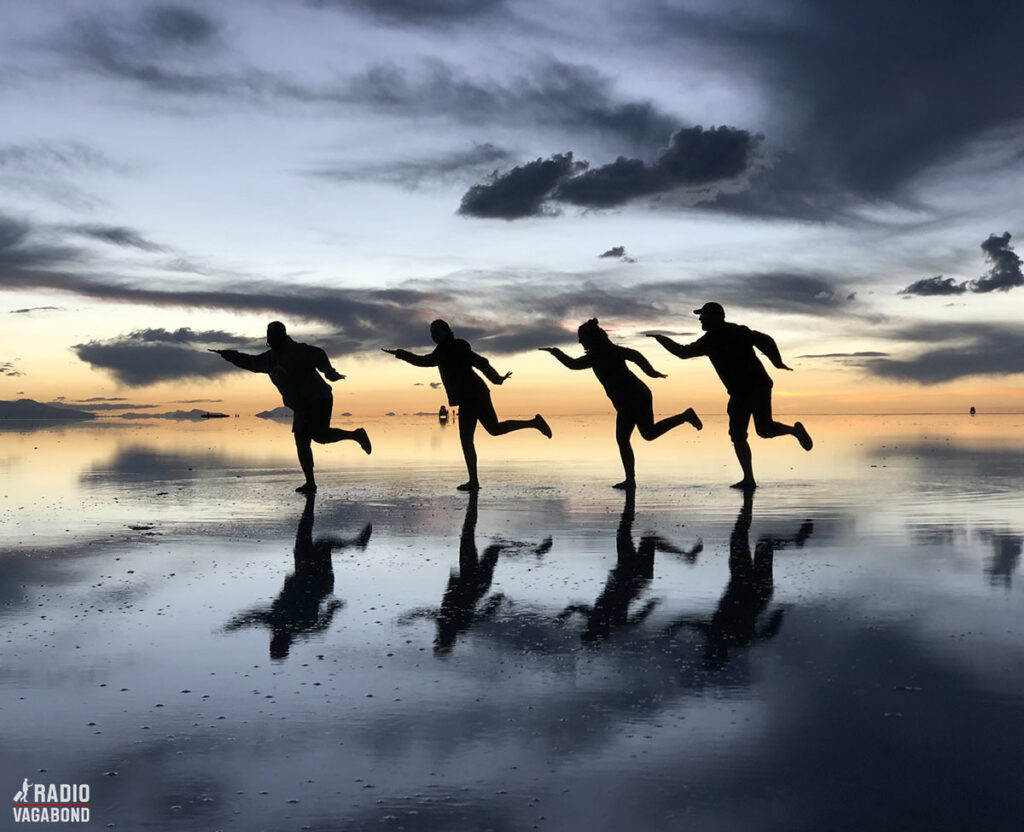
At night the salt flats become a natural mirror for the stars above, turning the world upside down once again. The sky is painted with countless celestial bodies, and the reflection on the thin layer of water seems like a glimpse into the cosmos itself. Stargazers flock to this remote corner of Bolivia to witness this spectacle.
Welcome to Mars
The next morning, we continued our trip to the southwestern part of the country, nearer to the border with Chile. First, we drive through “The High Flats” and then into the “High Andes” and Siloli Dessert. Being between 4500 and 4700 meters above sea level, it’s the highest dessert in South America. The high desert reminds me of Mars – and Nasa agree. They use the areas to test their Mars vehicles.
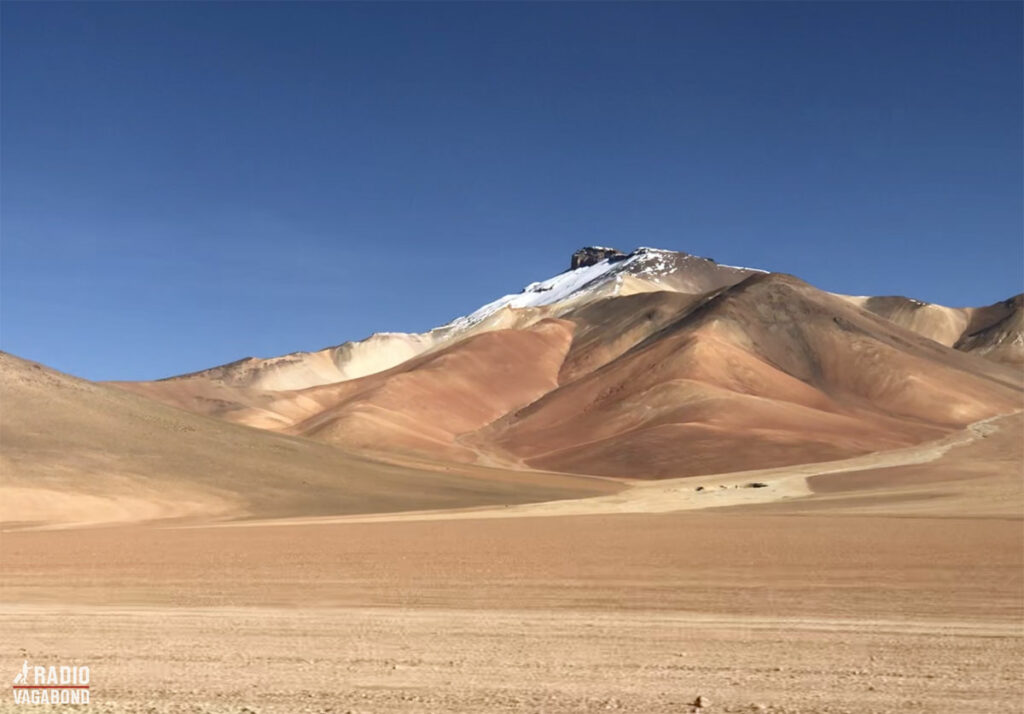
Laguna Q’ara and Laguna Colorada
We make a stop at a lake called Laguna Q’ara, and then continue a bit south to another high-altitude lake, named Laguna Colorada. It’s another one of Bolivia’s most captivating natural wonders.
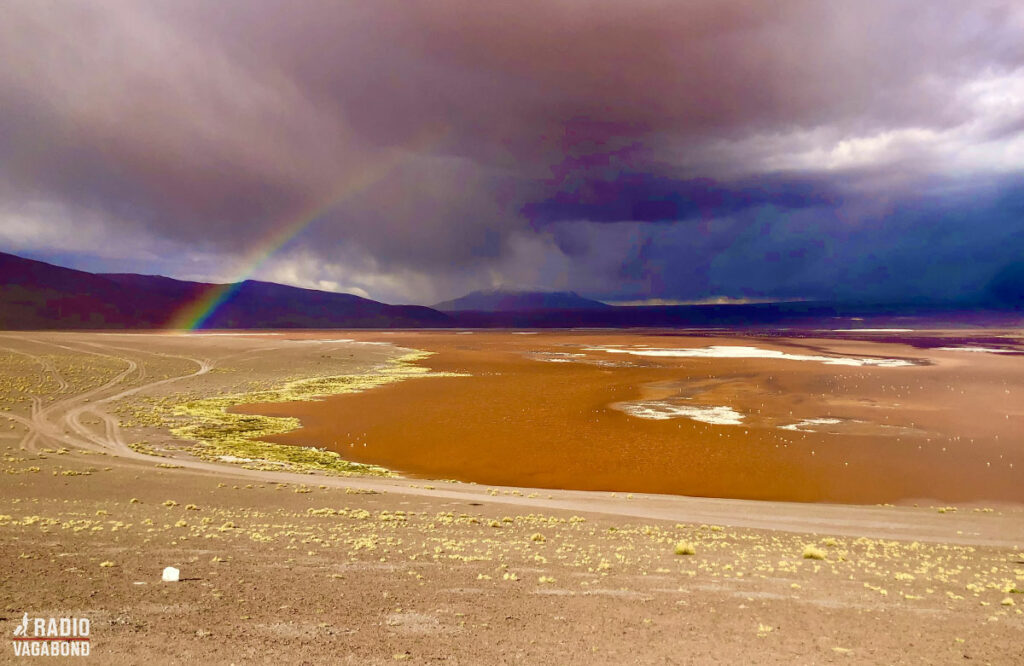
Laguna Colorada, or the Red Lagoon, gets its name from its striking red colour, which is a result of the high concentration of minerals in the water. The lake’s red colour is most visible during the dry season when the water level is lower.
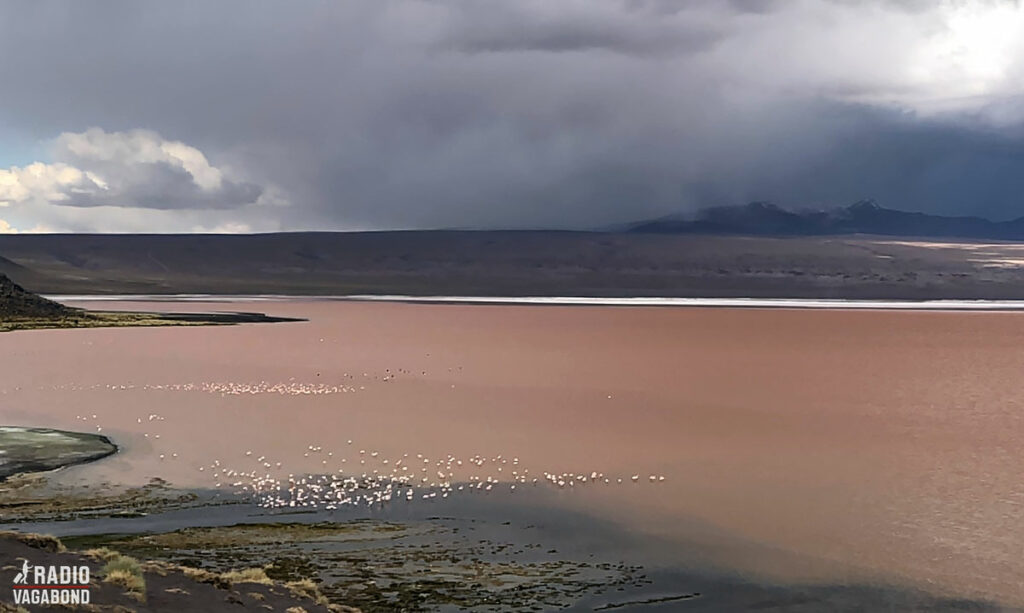
Flamingos
One of the most iconic features of Laguna Colorada is its resident population of flamingos. The lake is home to three species of flamingos and these elegant birds are attracted to the lake’s rich ecosystem and the contrast of the red waters against the pink flamingos creates a stunning and unforgettable sight.
Laguna Colorada’s almost otherworldly appearance, along with its flamingo population, make it a must-visit destination for nature enthusiasts and photographers exploring the stunning landscapes of southwestern Bolivia.
It truly looks surreal – and the rainbow that appeared when I took a photo of the colourful lake, made it even more stunning.
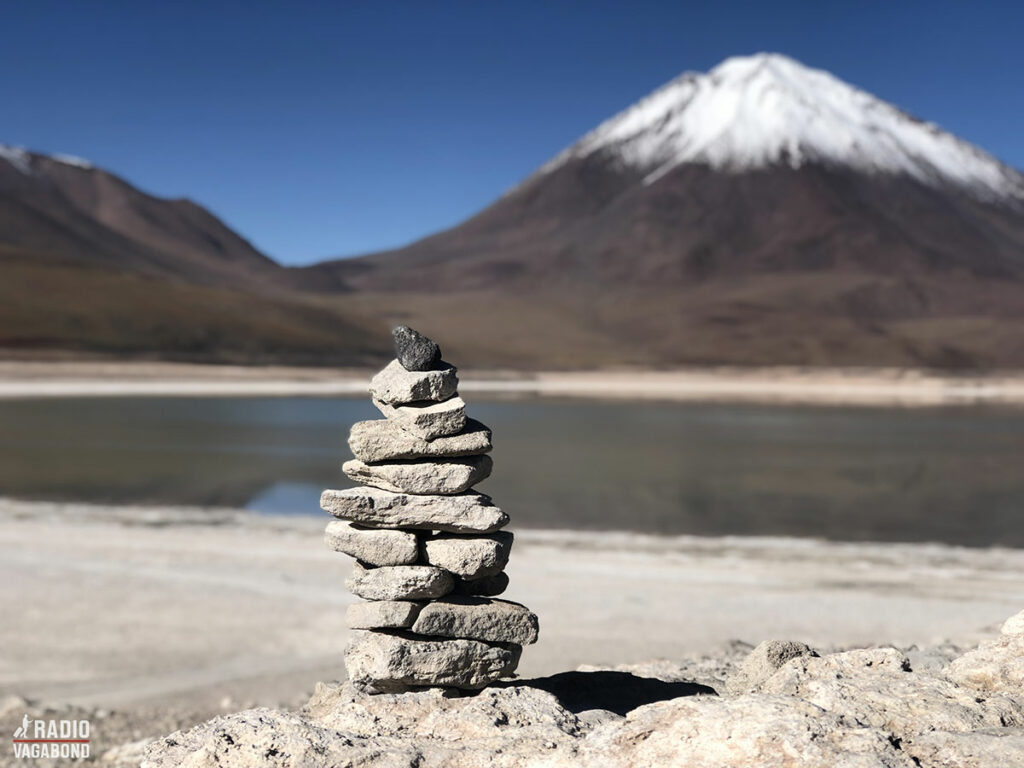
Simple Lodging
We spent the night at a Simple Mountain Lodge just south of the lake. And they weren’t kidding. It’s a rustic, modest, and simple lodge, designed to blend in with the natural surroundings. The lodge’s exterior is constructed from local materials, including stone and adobe, giving it an earthy and traditional appearance. It is a low-rise building that doesn’t stand out in the dramatic backdrop of the high Andes. The roof is made of rusty metal and natural materials to withstand the extreme weather conditions.
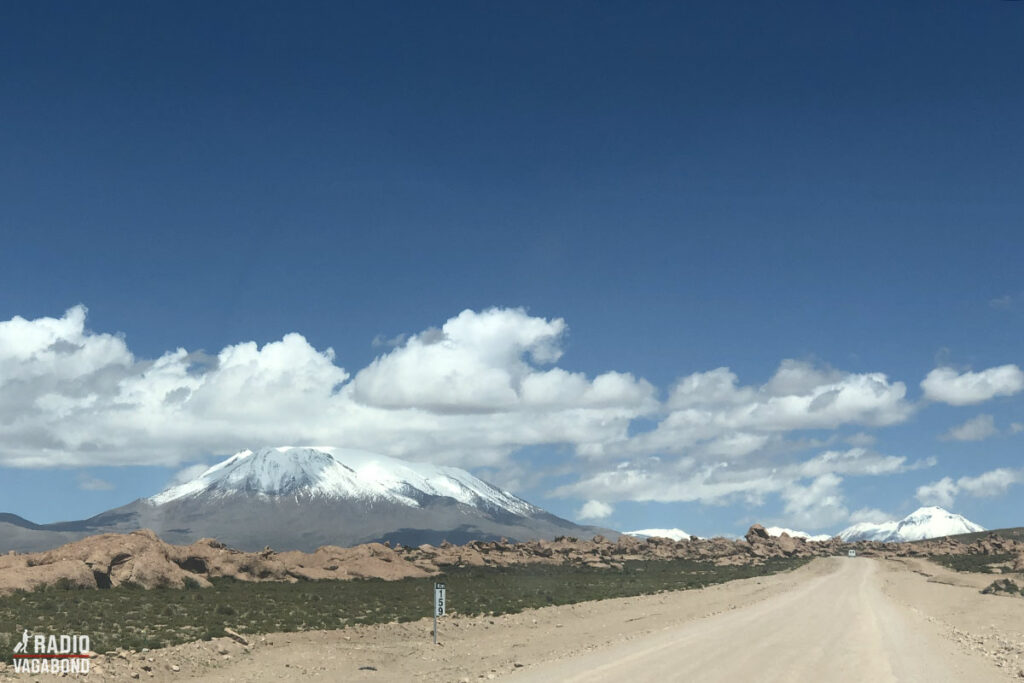
The lodge is situated in a picturesque location and surrounded by barren, windswept terrain, adding to its isolation and rugged charm. They offer a limited number of rooms with simple furnishings. Rooms with basic beds and with the cold temperatures at this high-altitude location, the lodge provided us with heavy blankets to combat the cold.
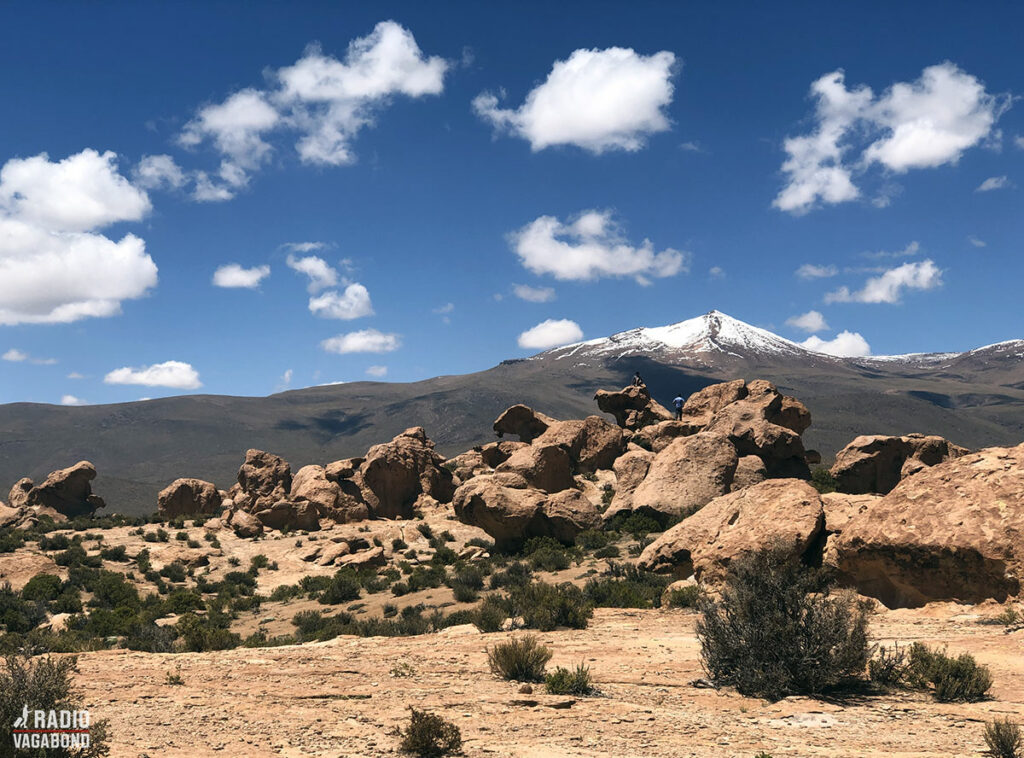
We were in a shared bedroom and also had a shared bathrooms with cold water showers. We had only two hours of electricity from a generator behind the building and could buy half an hour of slow Wi-Fi.
Overall, the focus here is on providing simple shelter to travellers in an extreme and beautiful environment. And we didn’t get to sleep long – because we had to get up at 5 am the next morning for yet another cool experience on the last day.
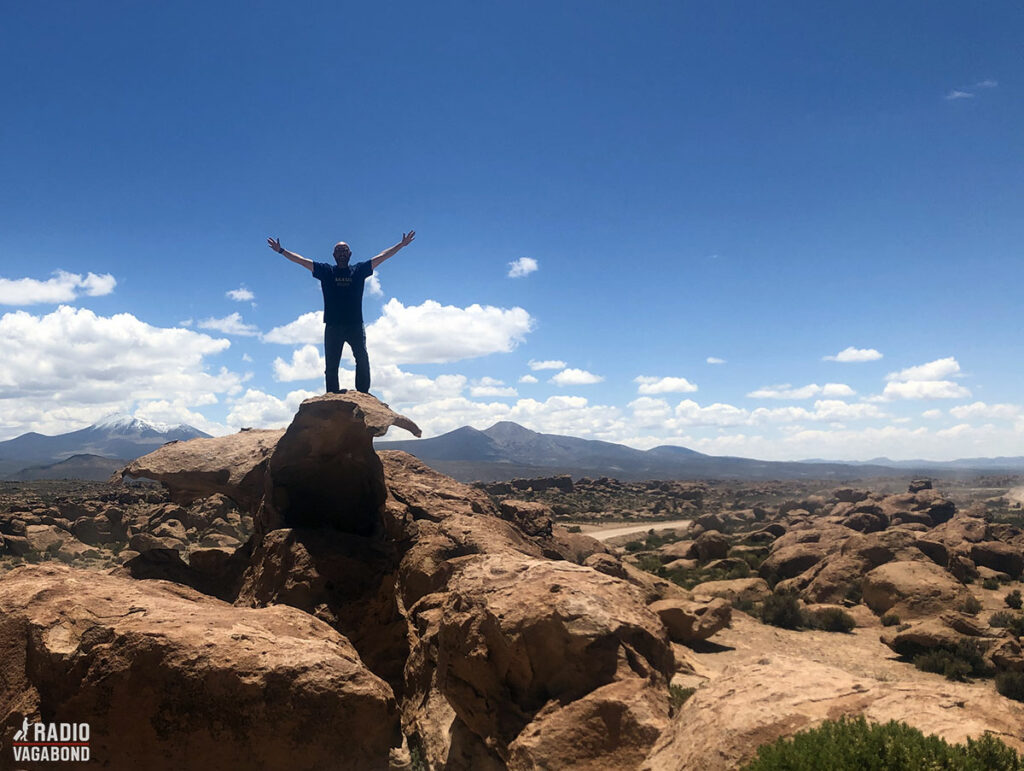
Thermal Bath and Geysers
Picture yourself waking up in the high Andes very early in the morning. The air is pure and crisp, and the world around you is serene. After a short drive further south, we’re greeted by the breath-taking sight of Laguna Salada. Their still waters reflecting the early morning sky with hues of orange, pink, and gold.
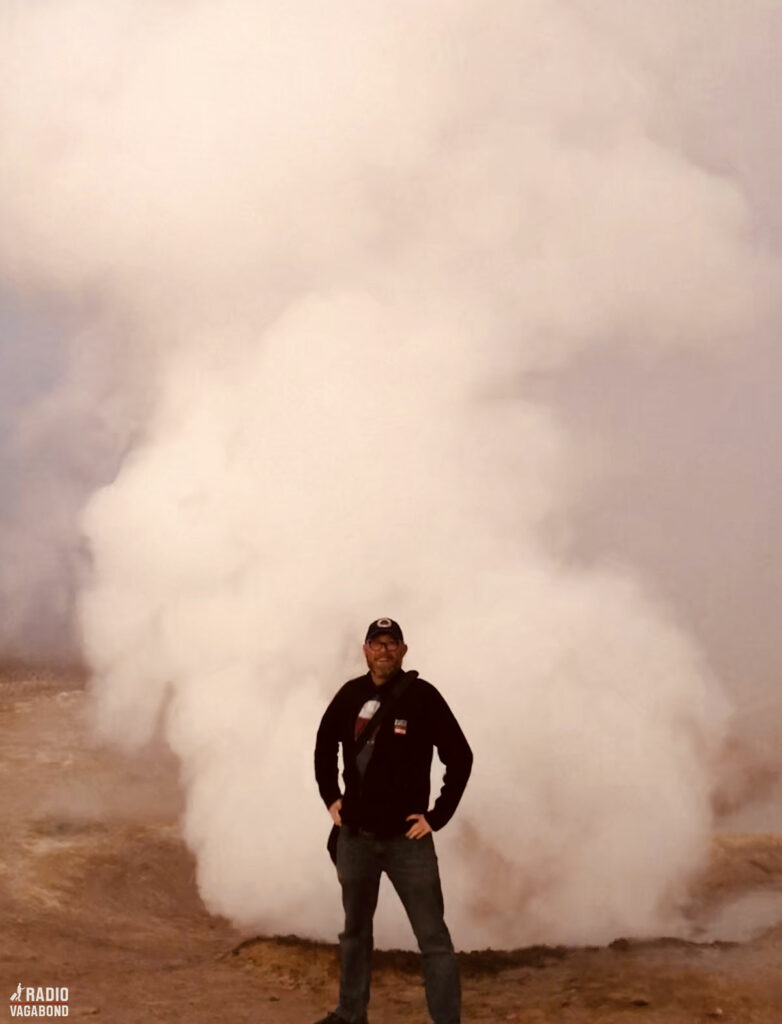
These remarkable geysers are natural wonders that erupt with bursts of steam and hot water, putting on a mesmerizing show. The geysers add an exciting element to our morning as we watch them spout their steam into the crisp air.
We make our way to Termas de Polques at Laguna Salada, the natural hot springs with a pool of steaming natural thermal water. The steam gently rises from these geothermal pools, creating a mystic ambiance. As we’re in the water, we can watch the rocky formations and the rugged beauty of the Andes. These pools offer a soothing warmth that’s especially inviting on a chilly morning like this one.
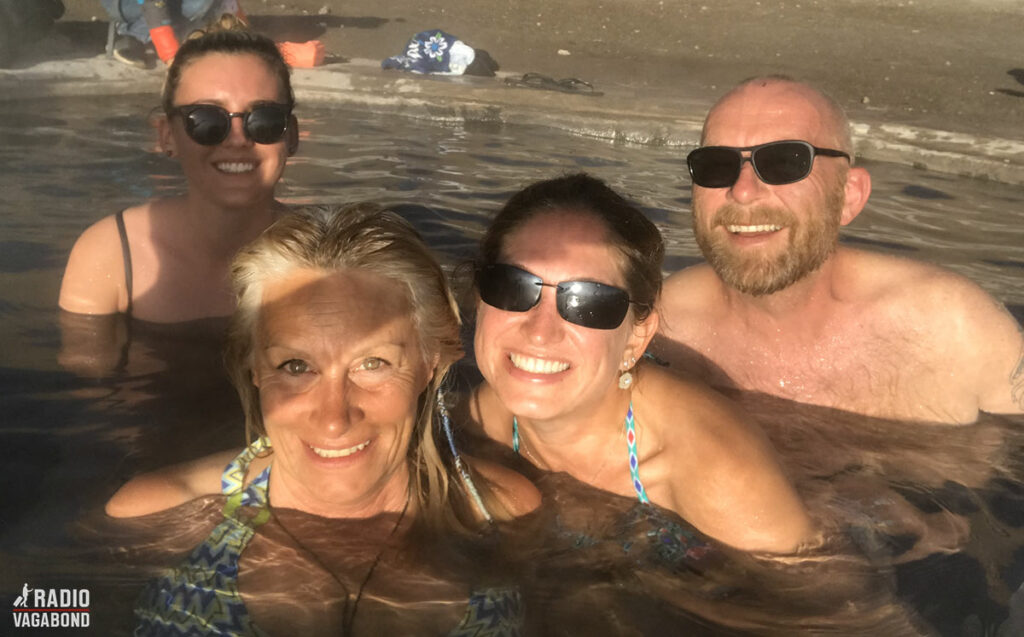
After soaking, we had a light breakfast before getting back in the 4×4. Sipping hot coffee while taking in the panoramic views is a fantastic way to start the last day on this trip in perfect harmony with the natural world.
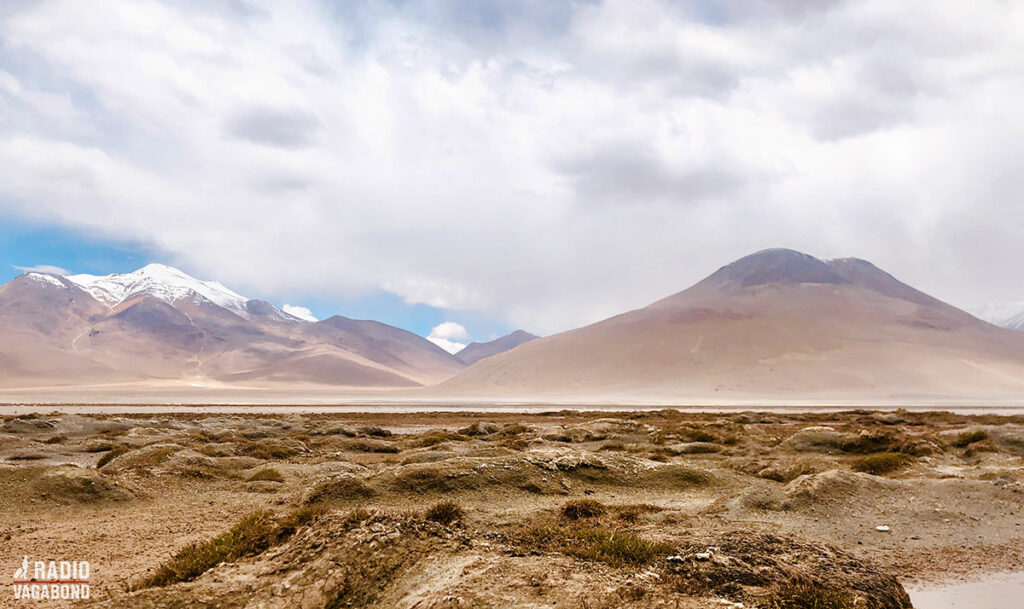
Out of Breath in the Thin Air
As we’re heading down from the mountain, I can feel that we’ve been in high altitude for a while, and I felt a bit of altitude sickness.
I start feeling a bit off. I get a pounding headache that feels like a tight band around my head. This is quite common at high altitudes, I was told. I feel a tired. I thought it was because we only got a few hours of sleep – and I had to sleep without my sleep apnoea mask because there was no electricity. But I also feel weak, making even simple tasks like walking 30 meters to the car feel exhausting and made me out of breath. And a bit of dizziness or light-headedness making it difficult to keep my balance.
It helped sitting still in the car as we were ascending from the mountain and drink plenty of water.
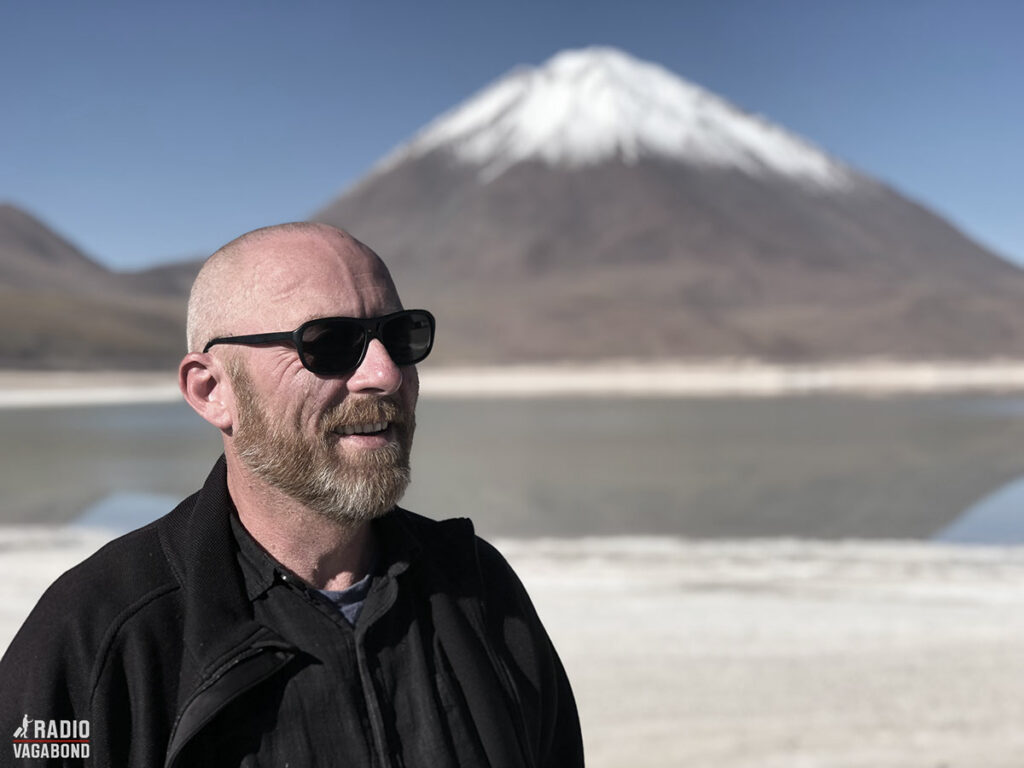
Heading to Chile
At the end of the trip, the car was driving back to Uyuni, but we asked to be dropped off at the border to Chile and continue our South American journey that way. It was truly three remarkable days in this picturesque part of the world.
Poem Written by an AI
In the land of Southern Bolivia, where dreams unfurl,
A tale told on The Radio Vagabond’s whirl.
First, they strolled to the Train Cemetery’s gate,
Where old locomotives met a rusty, grim fate.Then they ventured forth to a wonder untold,
Where Mother Earth’s secrets in beauty unfold.
Salar de Uyuni, the salt flats so wide,
A mirror-like canvas, reflecting with pride.Creative photos, a dinosaur’s playful attack,
As the sun dipped below, never looking back.
Colors of sunset, a sight so divine,
Painting the heavens, as they roamed the salt line.The journey continued, the high Andes in sight,
A Martian landscape, bathed in red light.
Laguna Colorada, a lake painted bold,
Pink flamingos danced on shores of crimson gold.In high altitudes, where the air is so thin,
They took a thermal bath, a new day to begin.
Geysers erupted, a morning’s delight,
In the heart of the Andes, a mesmerizing sight.A journey so splendid, a bucket list feat,
In the passion of travel, an adventure complete.
As the episode ends, in our hearts it shall stay,
The Radio Vagabond’s tales, in our minds, will play.
I WOULD LIKE TO HEAR FROM YOU!
Please tell me where are you and what are you doing as you listen to this episode? You can either send me an email on listener@theradiovagabond.com, go to TheRadioVagabond.com/Contact or send me a voice message by clicking on the banner.

Either way, I would love to hear from you. It’s so nice to know who’s on the other end of this.
SPONSOR
A special thank you to my sponsor, Hotels25.com, who always provide me with the best, most affordable accommodation wherever I am in the world.
Hotels25 scans for prices on the biggest and best travel sites (like Booking.com, Hotels.com, Agoda and Expedia) in seconds. It finds deals from across the web and put them in one place. Then you just compare your options for the same hotel, apartment, hostel or home and choose where you book.
When you book with Hotels25, you get access to 5,000,000 hotel deals. And it’s “best price guaranteed.”
PRODUCED BY RADIOGURU
The Radio Vagabond is produced by RadioGuru. Reach out if you need help with your podcast.

